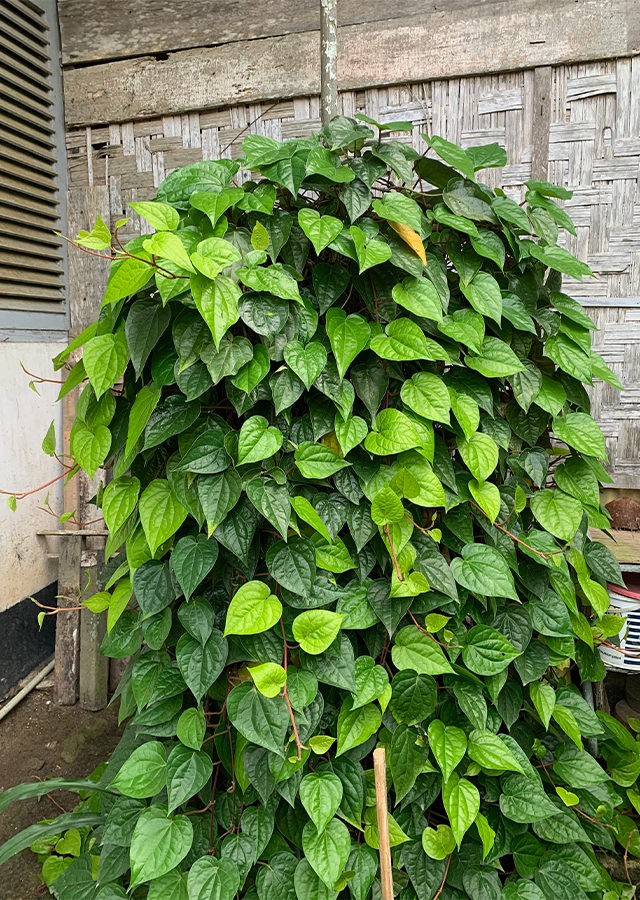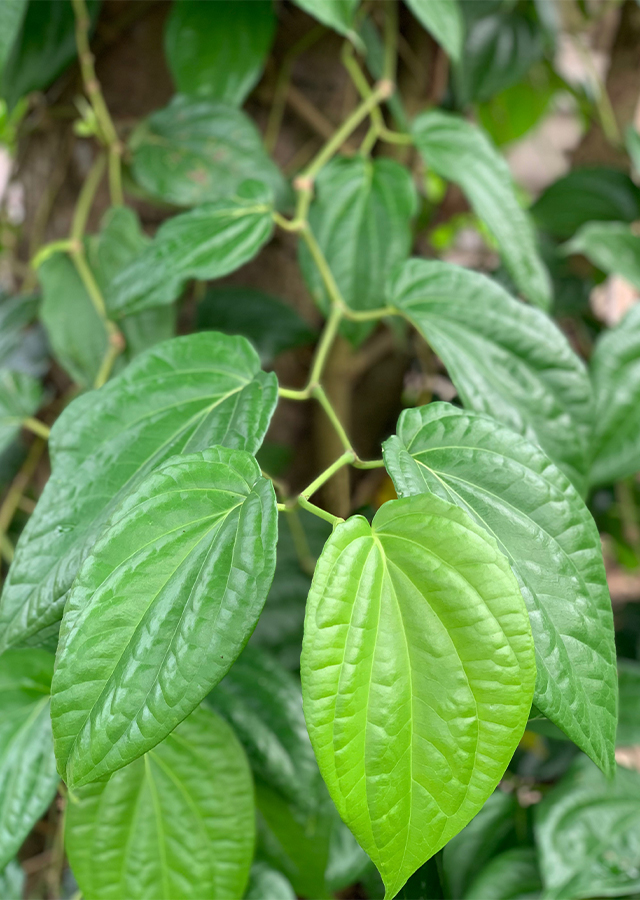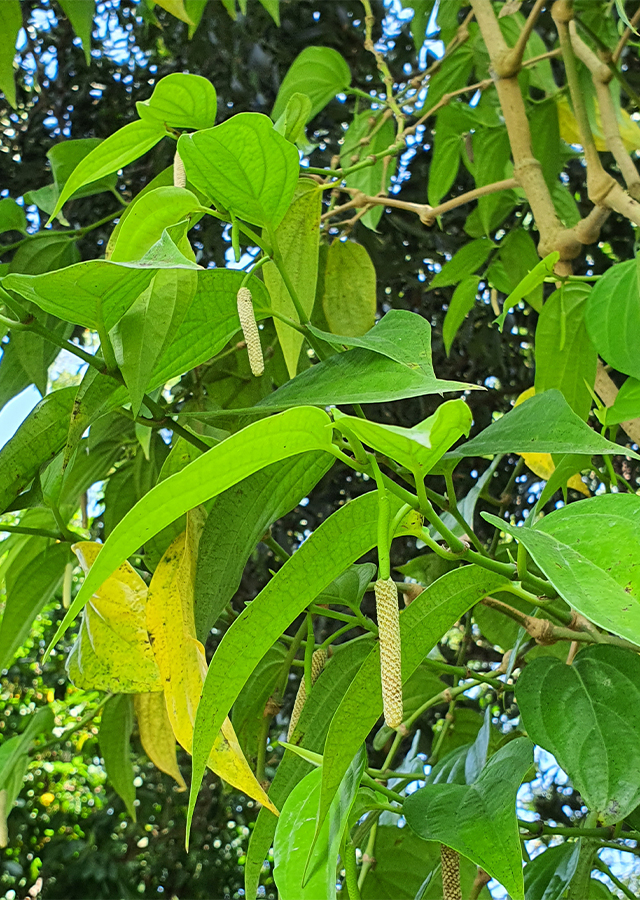Betel
Piper betle L.
Piperaceae
Location in our garden
Principal



Synonym
Artanthe hexagyna Miq.
Betela mastica Raf.
Chavica auriculata Miq.
Habitus
Climbers. Evergreen perennial shrub, climbing, and producing woody stems 5-20 m long .
Part Used
Leaves
Seeds
Fruit
Roots
Growing Requirements
Need Shade
Habitat
Terrestrial
Overview
Betel is native to Central and Eastern Malesia and was cultivated in Malesia and tropical Asia more than 2,500 years ago. Much later, it entered Madagascar and East Africa and was introduced into the West Indies as well. In India and other countries in South-East Asia, such as Vietnam and China, it is commonly distributed in damp forests and is propagated. It is widely used as part of a chewing combination that also includes the Betel palm (Areca spp.) and also has a range of medicinal uses.
Vernacular Names
Sirih (Indonesian), Trầu (Vietnamese), Phulu (Thailand), Ikmo (Philippines), Ph'u (Laos), Betelpfeffer (German), Bétel (French), Ju jiang (Chinese), Tâmûl (Arab), Kun ya (Burmese).
Agroecology
Betel is a tropical lowland herb, generally at altitudes below 900 m. The mean annual temperature falls within the 22-27 °C range, with an average annual precipitation of 2,250-4,750 mm. It prefers a place in the shade and needs wind protection as well. It prefers loamy and artificial friable soil, rich in organic matter and with a pH of approximately 7-7.5.
Morphology
- Roots - few, sparingly branched and short. The nodes are conspicuously swollen and the internodes are elongated.
- Stem - swollen at the nodes; orthotropic branches vegetative.
- Leaves - alternate, coriaceous, rather variable; petiole 1-2.5 cm long; blade ovate to ovate-oblong, 5-20 cm × 2-11 cm, base cordate, rounded or oblique, margin entire, shiny bright green.
- Flowers - dioecious, male spike up to 12 cm long, 2 stamens, female spike up to 5 cm × 5 mm, crowded with female flowers with 3-5 stigmas.
- Fruits - coalescing, fully embedded in the pulp and concrescent with the rachis.
- Seeds - smooth, oblong to globose-obovoid, 2.25 to 2.6 mm long, and about 2 mm in diameter. Stigmas are 4 to 6.
Cultivation
- Propagated by cuttings, 30-45 cm long, taken from the tips of vertical shoots. Usually, cuttings have 3- 5 nodes and are planted in the soil with the lowest 2 nodes buried. They are bound to the support as it starts to sprout and crawl along.
Chemical Constituents
Chavibetol, chavibetol acetate, caryophyllene, allylpyrocatechol diacetate, campene, chavibetol methyl ether, eugenol, a-pinene, β-pinene, u-limonene, saprobe, 1-8-cineol, allylpyrocatechol monoacetate, terpinen-4-ol, safrole, eugenyl acetate, hydroxyl chavicol, cadinenecarvacrol, allyl catechol, chavicol, pcymene, cineole, and estragole.
Traditional Medicinal Uses
- The consumption of P. betel beneficially affects the metabolism of glucose (reduction of blood glucose and glycosylated hemoglobin).
- Vaseline essential oil and cold ethanolic extract of P. betel leaves have a significant healing effect on skin diseases.
- The crushed fresh leaves are used as antiseptic for cuts and wounds in the Philippines.
- Roots, leaves, and fruits are considered to be carminative, stimulant, corrective, and prophylactic for malaria prevention and treatment in China.
- The leaves are used in India to treat eczema, lymphangitis, asthma, and rheumatism. Leaves are mixed with mustard oil, warmed, and are applied to the chest for treatment of reducing cough and dyspnoea, usually for children and the elderly.
Part Used
Reference Sources
- Baviskar, H.P., Dhake, G.T., Kasai, M.A., Chaudhari, N.B. & Deshmukh, T. A. (2017). Review of Piper betle. Research Journal of Pharmacognosy and Phytochemistry. 9(2):128-134. doi: 10.5958/0975-4385.2017.00024.3.
- Patel, N.M., Jain, D.D., Suryawanshi, H.P., & Pawar, S.P. (2019). Phytopharmacological study of Piper Betle leaf. Saudi Journal of Medical and Pharmaceutical Sciences 5(11):964-971.
- Rekha, V.P.B., Kollipara, B.R.S.S.M., Gupta, S., Bharath, Y. & Pulicherla, K.K. (2014). A review on Piper betle L.: nature’s promising medicinal reservoir. American Journal of Ethnomedicine 1(5):276-289.
- Rimando, A.M., Han, B.H., Park, J.H. & Cantoria, M.C. (1986). Studies on the constituents of Philippine Piper betle leaves. Archives of Pharmacal Research. 9:93–97. https://doi.org/10.1007/BF02857217.
- Santhakumari, P., Prakasam, A. & Pugalendi, K.V. (2006). Antihyperglycemic activity of Piper betle Leaf on streptozotocin-induced diabetic rats. Journal of Medicinal Food 9(1):108–112.


